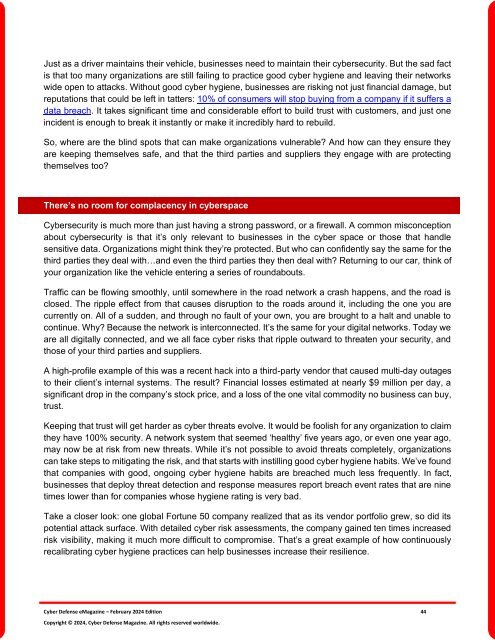The Cyber Defense eMagazine February Edition for 2024
Cyber Defense eMagazine February Edition for 2024 #CDM #CYBERDEFENSEMAG @CyberDefenseMag by @Miliefsky a world-renowned cyber security expert and the Publisher of Cyber Defense Magazine as part of the Cyber Defense Media Group as well as Yan Ross, Editor-in-Chief and many more writers, partners and supporters who make this an awesome publication! 155 page February Edition fully packed with some of our best content. Thank you all and to our readers! OSINT ROCKS! #CDM #CDMG #OSINT #CYBERSECURITY #INFOSEC #BEST #PRACTICES #TIPS #TECHNIQUES
Cyber Defense eMagazine February Edition for 2024 #CDM #CYBERDEFENSEMAG @CyberDefenseMag by @Miliefsky a world-renowned cyber security expert and the Publisher of Cyber Defense Magazine as part of the Cyber Defense Media Group as well as Yan Ross, Editor-in-Chief and many more writers, partners and supporters who make this an awesome publication! 155 page February Edition fully packed with some of our best content. Thank you all and to our readers! OSINT ROCKS! #CDM #CDMG #OSINT #CYBERSECURITY #INFOSEC #BEST #PRACTICES #TIPS #TECHNIQUES
You also want an ePaper? Increase the reach of your titles
YUMPU automatically turns print PDFs into web optimized ePapers that Google loves.
Just as a driver maintains their vehicle, businesses need to maintain their cybersecurity. But the sad fact<br />
is that too many organizations are still failing to practice good cyber hygiene and leaving their networks<br />
wide open to attacks. Without good cyber hygiene, businesses are risking not just financial damage, but<br />
reputations that could be left in tatters: 10% of consumers will stop buying from a company if it suffers a<br />
data breach. It takes significant time and considerable ef<strong>for</strong>t to build trust with customers, and just one<br />
incident is enough to break it instantly or make it incredibly hard to rebuild.<br />
So, where are the blind spots that can make organizations vulnerable? And how can they ensure they<br />
are keeping themselves safe, and that the third parties and suppliers they engage with are protecting<br />
themselves too?<br />
<strong>The</strong>re’s no room <strong>for</strong> complacency in cyberspace<br />
<strong>Cyber</strong>security is much more than just having a strong password, or a firewall. A common misconception<br />
about cybersecurity is that it’s only relevant to businesses in the cyber space or those that handle<br />
sensitive data. Organizations might think they’re protected. But who can confidently say the same <strong>for</strong> the<br />
third parties they deal with…and even the third parties they then deal with? Returning to our car, think of<br />
your organization like the vehicle entering a series of roundabouts.<br />
Traffic can be flowing smoothly, until somewhere in the road network a crash happens, and the road is<br />
closed. <strong>The</strong> ripple effect from that causes disruption to the roads around it, including the one you are<br />
currently on. All of a sudden, and through no fault of your own, you are brought to a halt and unable to<br />
continue. Why? Because the network is interconnected. It’s the same <strong>for</strong> your digital networks. Today we<br />
are all digitally connected, and we all face cyber risks that ripple outward to threaten your security, and<br />
those of your third parties and suppliers.<br />
A high-profile example of this was a recent hack into a third-party vendor that caused multi-day outages<br />
to their client’s internal systems. <strong>The</strong> result? Financial losses estimated at nearly $9 million per day, a<br />
significant drop in the company’s stock price, and a loss of the one vital commodity no business can buy,<br />
trust.<br />
Keeping that trust will get harder as cyber threats evolve. It would be foolish <strong>for</strong> any organization to claim<br />
they have 100% security. A network system that seemed ‘healthy’ five years ago, or even one year ago,<br />
may now be at risk from new threats. While it’s not possible to avoid threats completely, organizations<br />
can take steps to mitigating the risk, and that starts with instilling good cyber hygiene habits. We’ve found<br />
that companies with good, ongoing cyber hygiene habits are breached much less frequently. In fact,<br />
businesses that deploy threat detection and response measures report breach event rates that are nine<br />
times lower than <strong>for</strong> companies whose hygiene rating is very bad.<br />
Take a closer look: one global Fortune 50 company realized that as its vendor portfolio grew, so did its<br />
potential attack surface. With detailed cyber risk assessments, the company gained ten times increased<br />
risk visibility, making it much more difficult to compromise. That’s a great example of how continuously<br />
recalibrating cyber hygiene practices can help businesses increase their resilience.<br />
<strong>Cyber</strong> <strong>Defense</strong> <strong>eMagazine</strong> – <strong>February</strong> <strong>2024</strong> <strong>Edition</strong> 44<br />
Copyright © <strong>2024</strong>, <strong>Cyber</strong> <strong>Defense</strong> Magazine. All rights reserved worldwide.

















